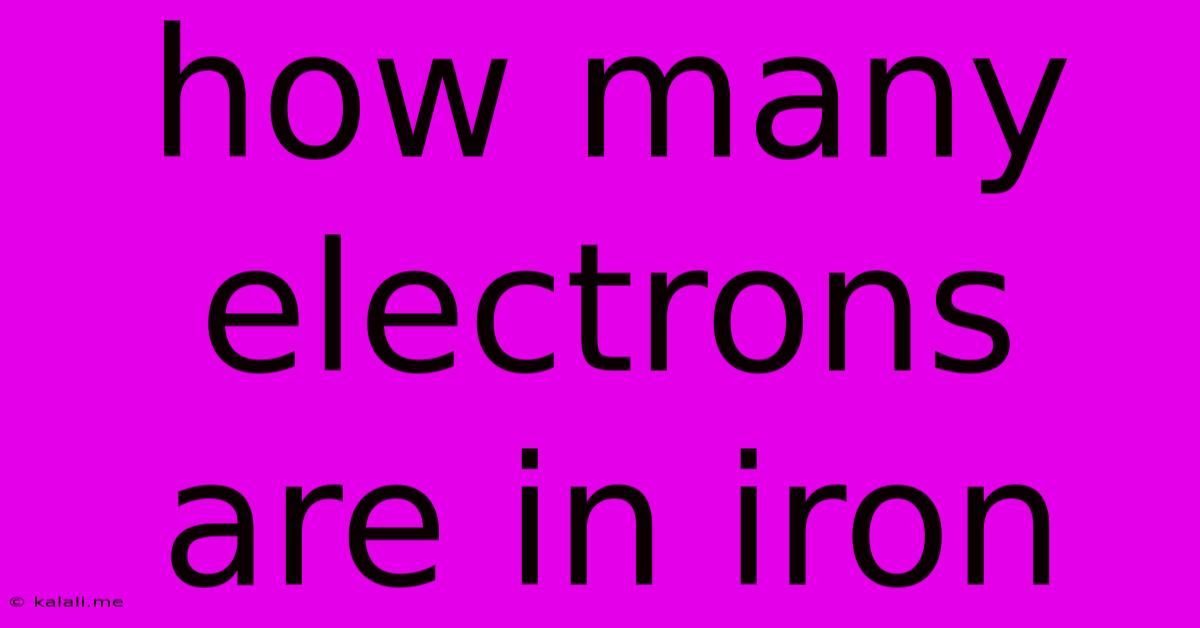How Many Electrons Are In Iron
Kalali
May 10, 2025 · 3 min read

Table of Contents
How Many Electrons Does Iron Have? A Deep Dive into Atomic Structure
Iron, a ubiquitous element crucial to life and industry, boasts a fascinating atomic structure. Understanding the number of electrons in an iron atom requires a basic grasp of atomic theory. This article will explain not only the answer but also the underlying principles, exploring isotopes and electron shells for a complete picture.
A Quick Answer: A neutral iron atom contains 26 electrons.
But why 26? Let's delve deeper. The number of electrons in an atom is directly related to its atomic number, which represents the number of protons in the atom's nucleus. Since atoms are electrically neutral (unless they're ions), the number of electrons equals the number of protons. Iron's atomic number is 26, therefore, a neutral iron atom has 26 electrons.
Understanding Atomic Structure and Electron Shells
Atoms are composed of three subatomic particles: protons, neutrons, and electrons.
- Protons: Positively charged particles located in the atom's nucleus. The number of protons defines the element.
- Neutrons: Neutral particles (no charge) also found in the nucleus. The number of neutrons can vary, leading to isotopes.
- Electrons: Negatively charged particles orbiting the nucleus in shells or energy levels. These electrons determine the atom's chemical properties and how it interacts with other atoms.
These electron shells are arranged in specific energy levels. The first shell can hold a maximum of two electrons, the second shell eight, the third shell eighteen, and so on. The electron configuration for iron reflects this arrangement.
Iron's Electron Configuration
The electron configuration shows how electrons are distributed across the shells. For iron (Fe), it's: 1s² 2s² 2p⁶ 3s² 3p⁶ 4s² 3d⁶. This means:
- Shell 1 (K shell): 2 electrons
- Shell 2 (L shell): 8 electrons (2s² + 2p⁶)
- Shell 3 (M shell): 14 electrons (3s² + 3p⁶ + 3d⁶)
- Shell 4 (N shell): 2 electrons (4s²)
Adding these up, we again arrive at a total of 26 electrons.
Isotopes and Electron Count
It's important to note that while the number of protons defines the element, the number of neutrons can vary. These variations are called isotopes. Different isotopes of iron have varying numbers of neutrons, but the number of electrons in a neutral atom of any iron isotope will always remain 26. The mass number (protons + neutrons) changes with isotopes, but the atomic number (and hence the electron count in a neutral atom) stays constant.
Iron's Importance and Electron Behavior
Iron's 26 electrons play a crucial role in its properties and applications. Its partially filled d-orbital (3d⁶) contributes to its magnetic properties and its ability to form various compounds. The behavior of these electrons, specifically their ability to lose or share electrons in chemical reactions, is fundamental to iron's role in everything from hemoglobin (oxygen transport in blood) to steel production.
In conclusion, understanding the number of electrons in iron is not simply about memorizing a number. It's about understanding the fundamental principles of atomic structure and how the arrangement of electrons dictates the chemical and physical properties of this essential element. The unwavering 26 electrons in a neutral iron atom are central to its widespread importance and diverse applications across numerous fields.
Latest Posts
Latest Posts
-
What Is Double Of 1 4 Cup
Jul 10, 2025
-
Prepare Me A Body And I Will Redeem Man
Jul 10, 2025
-
How Many Inches Is A Meter Stick
Jul 10, 2025
-
Soundtrack To Step Up 2 The Streets
Jul 10, 2025
-
Keebler Club And Cheddar Crackers Expiration Date
Jul 10, 2025
Related Post
Thank you for visiting our website which covers about How Many Electrons Are In Iron . We hope the information provided has been useful to you. Feel free to contact us if you have any questions or need further assistance. See you next time and don't miss to bookmark.